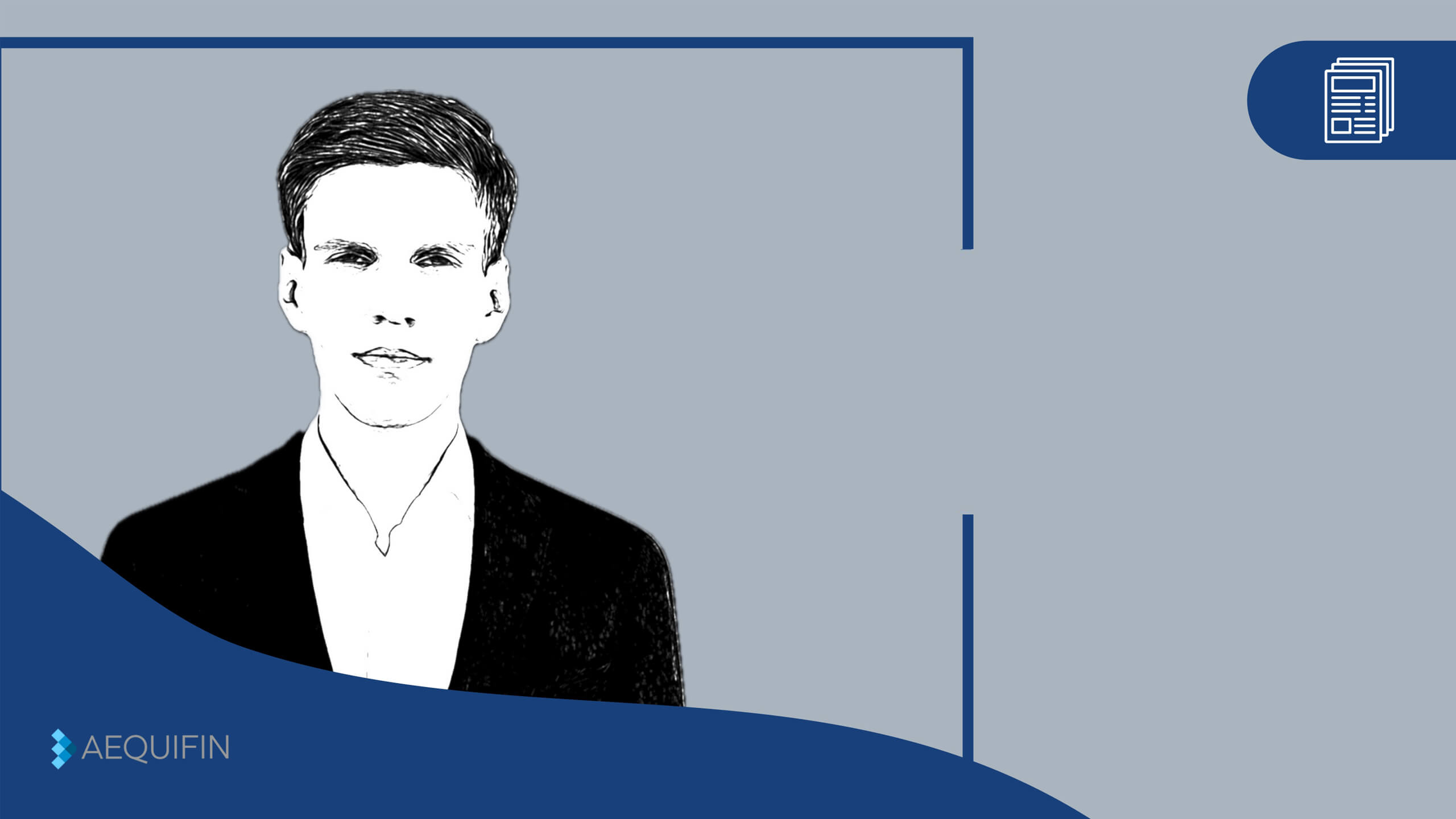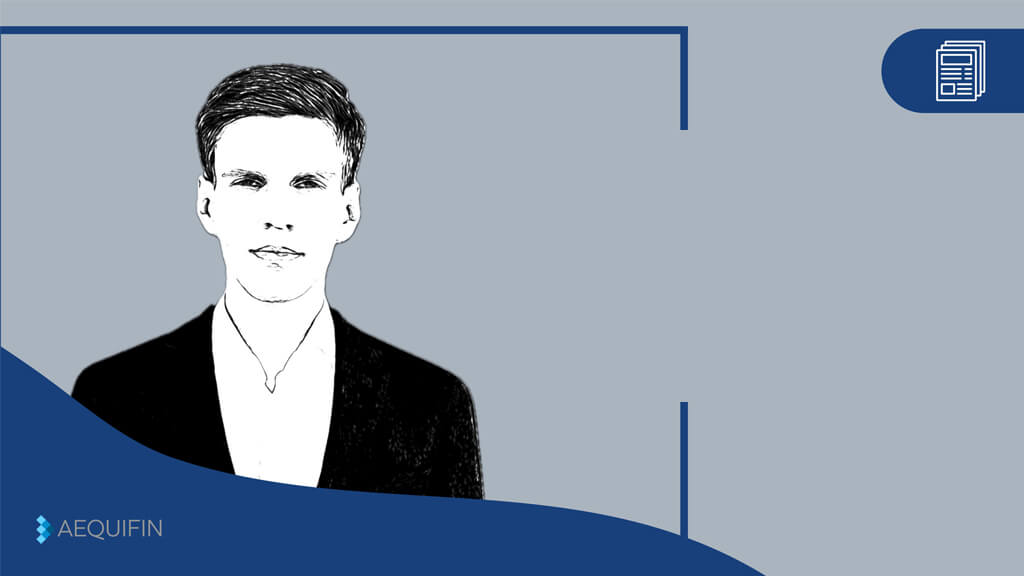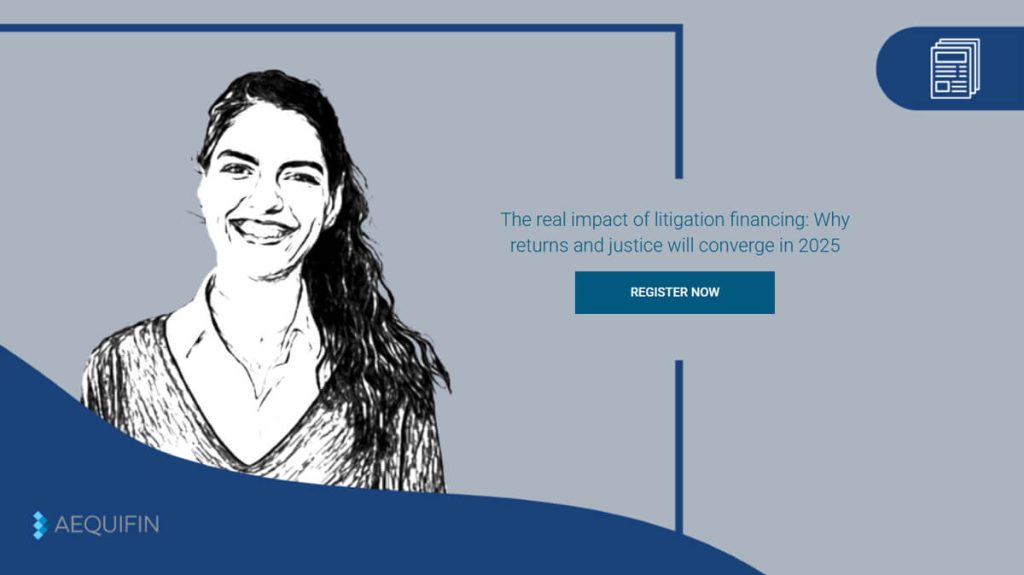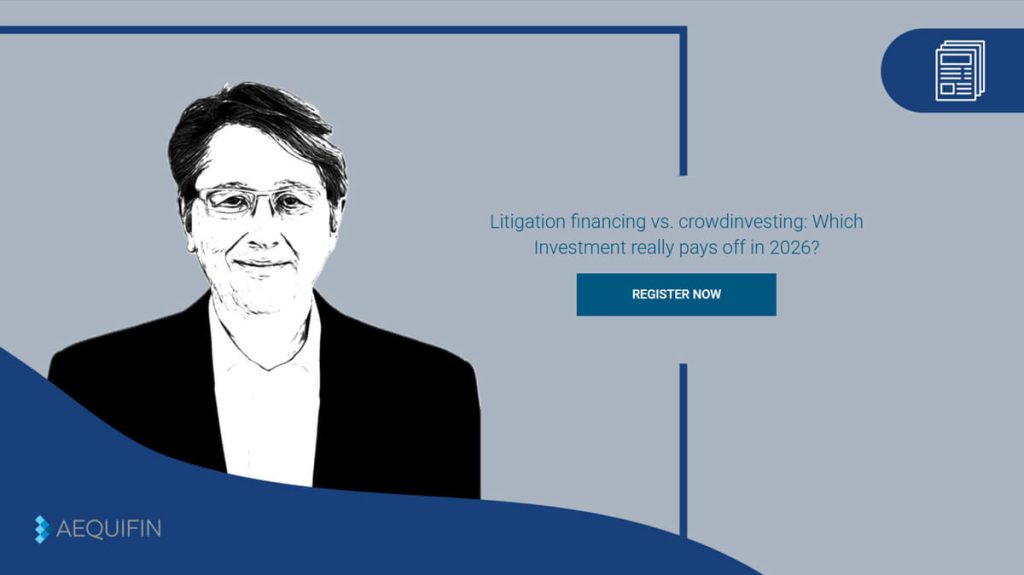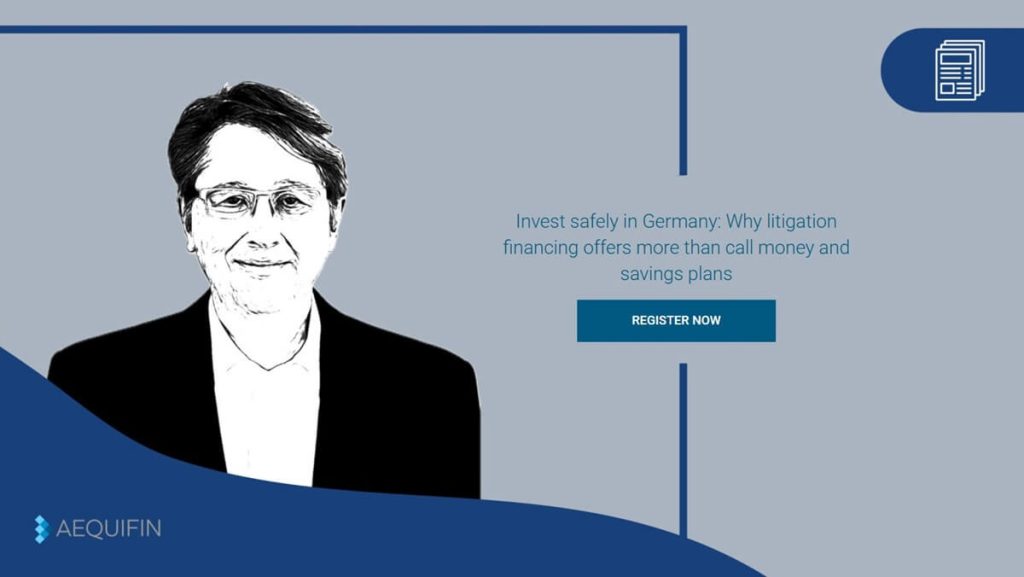Nowadays, investors are looking for ways to diversify their portfolios and invest independently of the stock market. One option often goes unnoticed — at least here in Germany. Litigation funding. But what’s behind it?
Why Litigation Funding Remains an Underrated Investment – At a Glance
- Why does litigation funding remain largely unknown to many investors, even though it offers attractive return opportunities?
- Why is the market growing in Germany but has so far barely been tapped by private investors?
- What advantages arise when investments in litigation funding are independent of the stock or real estate markets?
- How does AEQUIFIN give private investors access for the first time to vetted cases with calculable risk?
1. What Is Litigation Funding?
Litigation funding means that so-called litigation funders, as third parties, cover the costs of a legal dispute. This includes attorney fees, court costs, expert witnesses, and in the case of a loss even the opposing party’s costs. In return, the funder receives a share of the awarded amount if the case is successful. For investors, this opens up an entirely new asset class. They can finance lawsuits and profit in the event of success.
Why Does Litigation Funding Fly Under the Radar?
Many people hear the term “litigation funding” and initially think of government support such as legal aid. In fact, these are two completely different instruments.
Legal aid (PKH in Germany) is a social benefit. It is intended to give people with low income access to legal proceedings by having the state cover the costs.
The RVG (Lawyers’ Remuneration Act) regulates the fees that attorneys may charge for their services, regardless of who ultimately pays.
Litigation funding, on the other hand, is a private investment opportunity. Here, an external funder covers all the costs of the lawsuit and in return receives a share of the awarded sum if the case is successful. If the case fails, the funder bears the full cost risk.
Lack of Awareness Among the General Public
Why is this opportunity so little known? On the one hand, it’s because litigation funding was long reserved for large law firms, institutional investors, and specialized litigation funders. Private investors simply had no access. On the other hand, the topic is barely covered in traditional financial media.
In Germany, the market volume for litigation funding is estimated at under one billion euros per year. In comparison, according to the Federal Statistical Office, German households invest over 100 billion euros every year in stocks, funds, and insurance. The difference could hardly be greater.
Societal Focus on Traditional Investments
There is also a cultural factor. Many investors have so far focused on familiar asset classes such as stocks, real estate, or ETFs. These are perceived as safer or easier to understand. Investments in legal disputes, on the other hand, seem complex and less tangible.
But that’s exactly where the advantage lies for informed investors: hardly any competition, manageable and calculable risk, and a return potential that has so far largely remained untapped.
Tip: Also read our comparison of the best investments in 2025 and discover why litigation funding is a genuine alternative to stocks & more.
2. Litigation Funding Explained Simply
At first glance, litigation funding may seem complex, but at its core, it’s easy to understand. When a party wants to file a lawsuit with strong chances of success, they often lack the financial means to cover upfront court and attorney costs. This is where litigation funding comes in. An external funder covers all the costs of the legal proceedings.
In the event of success, the funder receives a contractually agreed share of the awarded amount. If the lawsuit fails, the funder bears the full cost risk. The claimant, on the other hand, remains financially unburdened.
What Are Examples of Litigation Funding in Practice?
A medium-sized company is defrauded of a significant amount. The legal prospects for success are good, but the litigation costs exceed the company’s reserves. Through AEQUIFIN, they find investors who finance the lawsuit. If the case results in a favorable judgment or settlement, the investors receive their investment back along with an attractive success-based return.
A Participation Model, Not a Loan
Litigation funding differs fundamentally from a loan from private individuals or a traditional personal loan. While loans require interest payments and fixed repayments regardless of the outcome, litigation funding is based on a participation model. Repayment occurs only in the event of success.
- No interest model with ongoing repayments for investors
- Attractive returns in the case of a successful outcome
- Shared risk with diversification opportunities and profit participation
You can find more background information in our article “Support Legal Cases & Profit with Litigation Funding for Sponsors.”
3. Is Litigation Funding an Alternative Investment?
In times of economic uncertainty, many investors look for investments that do not directly correlate with financial markets. Litigation funding offers exactly that.
Distinction from Traditional Assets
While stocks, real estate, and ETFs are heavily influenced by interest rates, inflation, or geopolitical events, the success of litigation funding depends solely on the outcome of the legal dispute. A judgment is not driven by market fluctuations but by legal arguments and evidence. This makes litigation funding a truly alternative investment for anyone looking to diversify their portfolio.
“Litigation funding is one of the few investments that remain almost independent of market fluctuations. This provides security in volatile times.”
Shorter Capital Commitment but Greater Flexibility
While real estate investments often come with terms of five to ten years, most legal proceedings are concluded within 12 to 24 months. Investors thus get their capital back more quickly and can reinvest it. An advantage that traditional asset classes can hardly offer.
Learn here why litigation funding can surpass real estate investments in many respects in 2025: “Litigation Funding vs. Real Estate: Which Is More Profitable in 2025?”
Realistically Calculating Return Opportunities
One particularly noteworthy aspect is transparency. Thanks to tools like the litigation cost calculator and the RVG calculator, investors can realistically assess the potential costs and returns even before committing to an investment.
👉 If you’d like to learn more about how litigation funding compares to stocks, read our article “Investing in Stocks vs. Litigation Funding.”
4. Making Litigation Funding Easily Accessible
What was previously reserved exclusively for institutional investors and large law firms is now being opened up to private investors by AEQUIFIN. The platform provides access to vetted legal cases across various fields, from labor law to inheritance law. Each case is thoroughly analyzed in advance by experienced lawyers to assess its chances of success, economic viability, and risks.
High Security Through Careful Pre-Screening
The quality of the investments offered is based on a clear principle: only cases with a high likelihood of success and a solid legal foundation are approved. So far, not a single case financed through AEQUIFIN has been lost. This track record is no coincidence but the result of a structured selection process and strict due-diligence mechanisms.
An overview of current cases can be found here: AEQUIFIN Litigation Fundings.
What Is a Practical Example of Litigation Funding?
Just recently, AEQUIFIN Professional successfully financed a complex inheritance case. A legal representative had helped an heir secure her claim to a substantial corporate estate. Despite years of support, she refused to pay him the contractually agreed success fee. Thanks to litigation funding, the claim was successfully enforced in court. For the beneficiary, this meant justice and financial security.
Read more about this case here: Inheritance Case Successfully Funded.
What Is a Practical Example of Litigation Funding?
Just recently, AEQUIFIN Professional successfully financed a complex inheritance case. A legal representative had helped an heir enforce her claim to a substantial corporate estate. Despite years of support, she refused to pay him the contractually agreed success fee. Thanks to litigation funding, the claim was successfully enforced in court. For the beneficiary, this meant justice and financial security.
Read more about this case here: Inheritance Case Successfully Funded.
Easy Access – Digital and Legally Secure
- Register on the platform.
- Review the cases using detailed documentation, calculations, and success prospects.
- Participate directly – fully digital, transparent, and legally secure.
Learn exactly how litigation funding works in our Step-by-Step Guide.
5. Why Is Now the Right Time for Litigation Funding?
Litigation funding in Germany is at a pivotal moment. The market is growing but has so far remained accessible to only a few investors.
A Market on the Rise with a Global Perspective
In Germany, the industry is clearly still at the beginning. In 2022, the market volume was around €500 million and is rising sharply. Globally, Research Nester valued the litigation finance market at USD 17.5 billion in 2024, with a forecast of over USD 67 billion by 2037 at an average annual growth rate of more than 11%. Credence Research projects around USD 37 billion by 2032 with a 10% CAGR — figures that ignite every growth engine.
“Litigation funding is not a speculative form of investment but an investment in legal claims with a real-economic foundation.”
An Investment Opportunity with a Clear Advantage
The success of litigation funding does not depend on stock prices, interest rates, or geopolitical events but solely on the outcome of a legally vetted case. For investors, this means:
- Market independence: Decisions based on legal grounds, not speculation.
- Early entry: The German market is open to early adopters who want to benefit from the start.
Calculable risk: Thanks to thorough pre-screening of cases and clear cost structures, uncertainties remain manageable.
